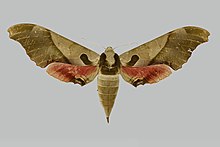Adhemarius blanchardorum
| Adhemarius blanchardorum | ||||||||||||
|---|---|---|---|---|---|---|---|---|---|---|---|---|

Adhemarius blanchardorum , male |
||||||||||||
| Systematics | ||||||||||||
|
||||||||||||
| Scientific name | ||||||||||||
| Adhemarius blanchardorum | ||||||||||||
| Hodges , 1985 |
Adhemarius blanchardorum is a butterfly ( moth ) fromthe swarm family (Sphingidae). For a North American Schwärmerart it was relatively late, despite its eye-catching appearance firstdescribed . It is rarely caught and so far it is only known from a very small area of distribution. The species is closely related to Adhemarius globifer , which occurs adjacent to the range of Adhemarius blanchardorum in northern Mexico. It is conceivable that these two species are conspecific, but this has not yet been adequately researched. The pre-imaginal stages are unknown.
features
The moths have a fore wing length of 43 to 53 millimeters. They are not variable in their color. The species can only be confused with Protambulyx strigilis in North America . The species differs from this, however, by its strong, green spots and the large dark basal spot on the forewings. The rather inconspicuously patterned similar species also does not have a strongly concavely curved outer edge of the forewing.
Occurrence
The species is so far only known from the Panther Pass at around 1,830 meters above sea level and the Green Gulch at around 1,675 meters above sea level in the Chisos Mountains in Big Bend National Park in Texas. There is no evidence from the neighboring mountains of Mexico, but this may also be due to the fact that the species was not sufficiently searched for there.
The animals found so far colonized a single, fairly deep gorge, which is somewhat protected from the harsh environmental influences of the surrounding desert and dry hills. There the soil temperature is relatively low and slightly more humid due to tree vegetation, which results in a microclimate that is unique in the Chisos Mountains.
Way of life
In his first description, Hodges reports that the imagines light traps only approached shortly before sunset and no further animals came later. However, other researchers are also said to have documented that the moths were attracted to the light until about an hour after sunset. Although the moths have only an approximately 21 millimeters long proboscis , but they seem to have a sufficiently well-developed muscles, suck nectar to. So far, however, no specimen has been spotted visiting the flowers. Butterflies have only been caught from early May to early July, although attempts have also been made in late summer and early autumn. There does not seem to be a second generation per year.
Despite a targeted search, the pre-imaginal stages of the species are so far unknown. However, it is assumed that they have the usual characteristics of the Smerinthinae . There are various assumptions about the possible food plants, which are derived from the fact that despite an intensive search on young shoots of various woody plants near places where moths have been caught, no caterpillars could be found. There is therefore the possibility that the species atypically feeds on a coniferous species, a low-growing herbaceous plant or on older parts of woody plants.
supporting documents
Individual evidence
- ↑ a b c d e f James P. Tuttle: The Hawkmoths of North America, A Natural History Study of the Sphingidae of the United States and Canada. The Wedge Entomological Research Foundation, Washington, DC 2007, ISBN 978-0-9796633-0-7 .
literature
- James P. Tuttle: The Hawkmoths of North America, A Natural History Study of the Sphingidae of the United States and Canada. The Wedge Entomological Research Foundation, Washington, DC 2007, ISBN 978-0-9796633-0-7 .
